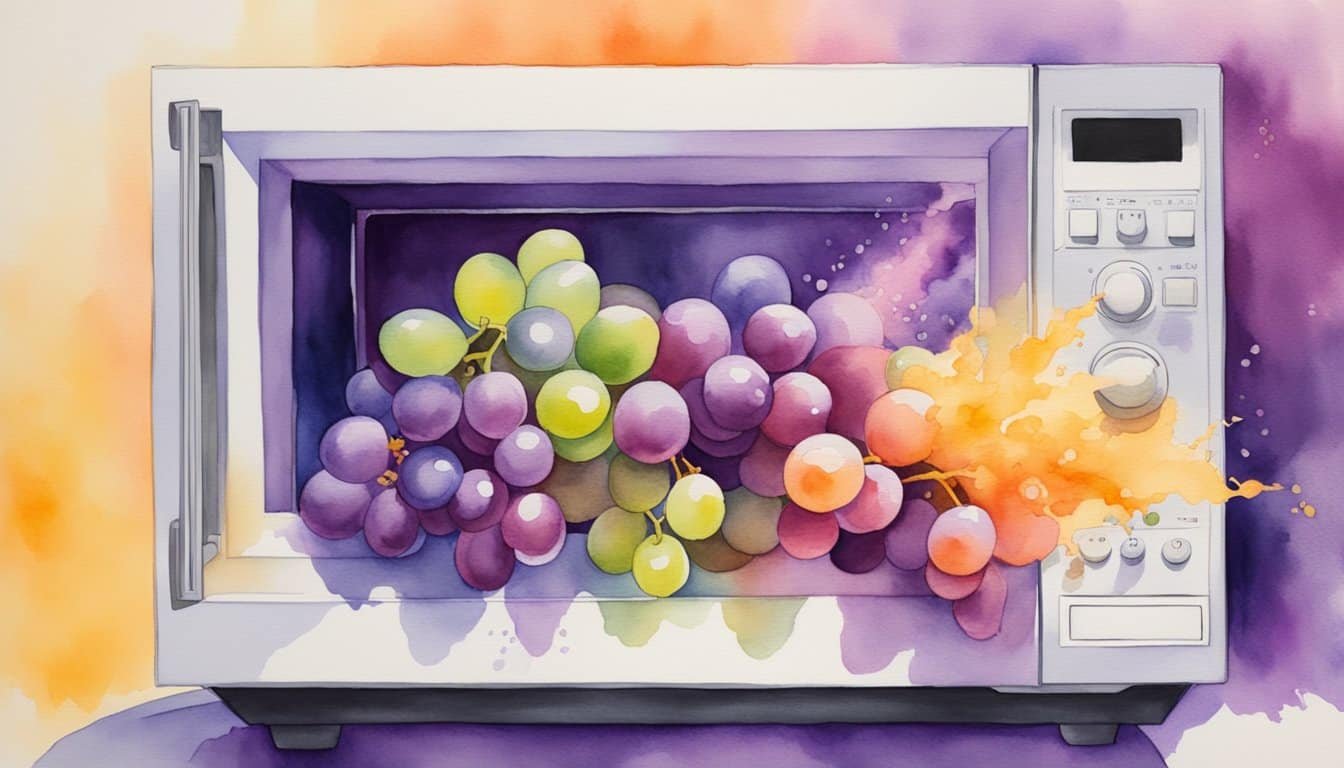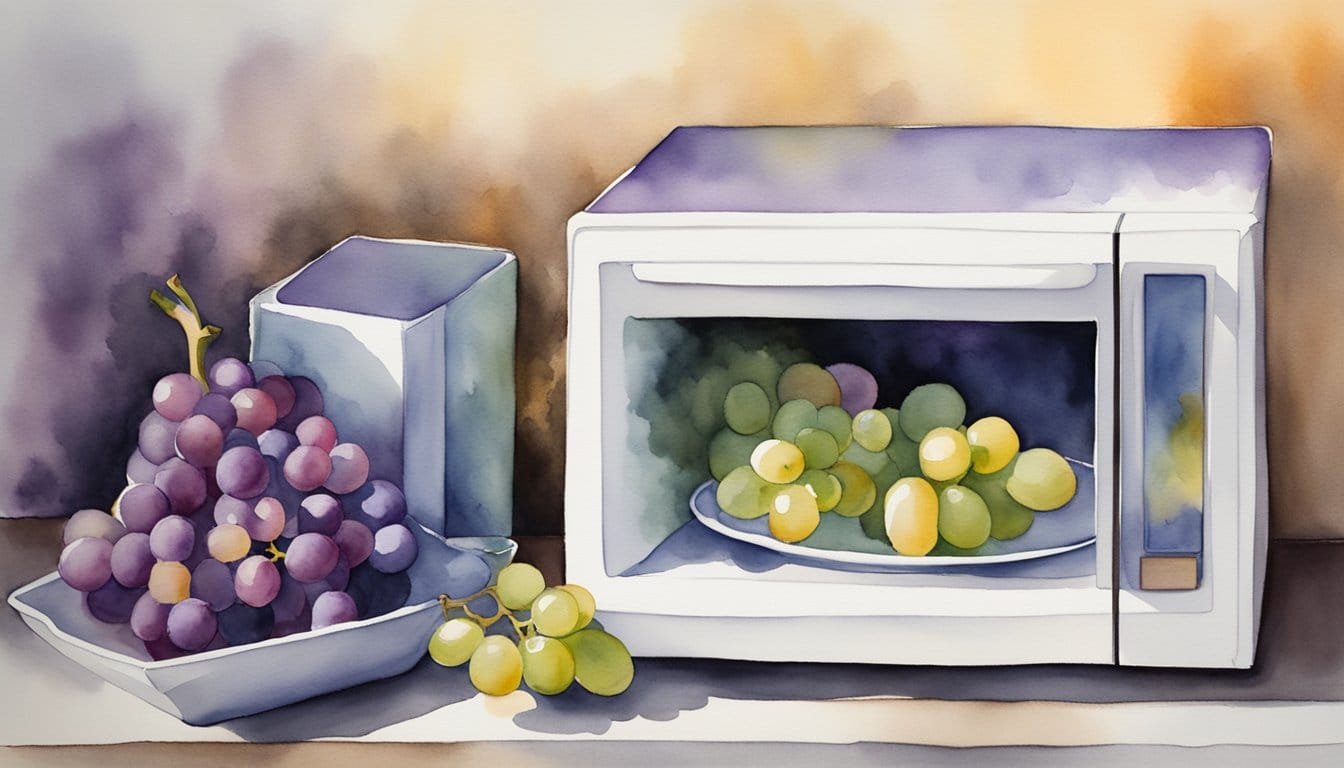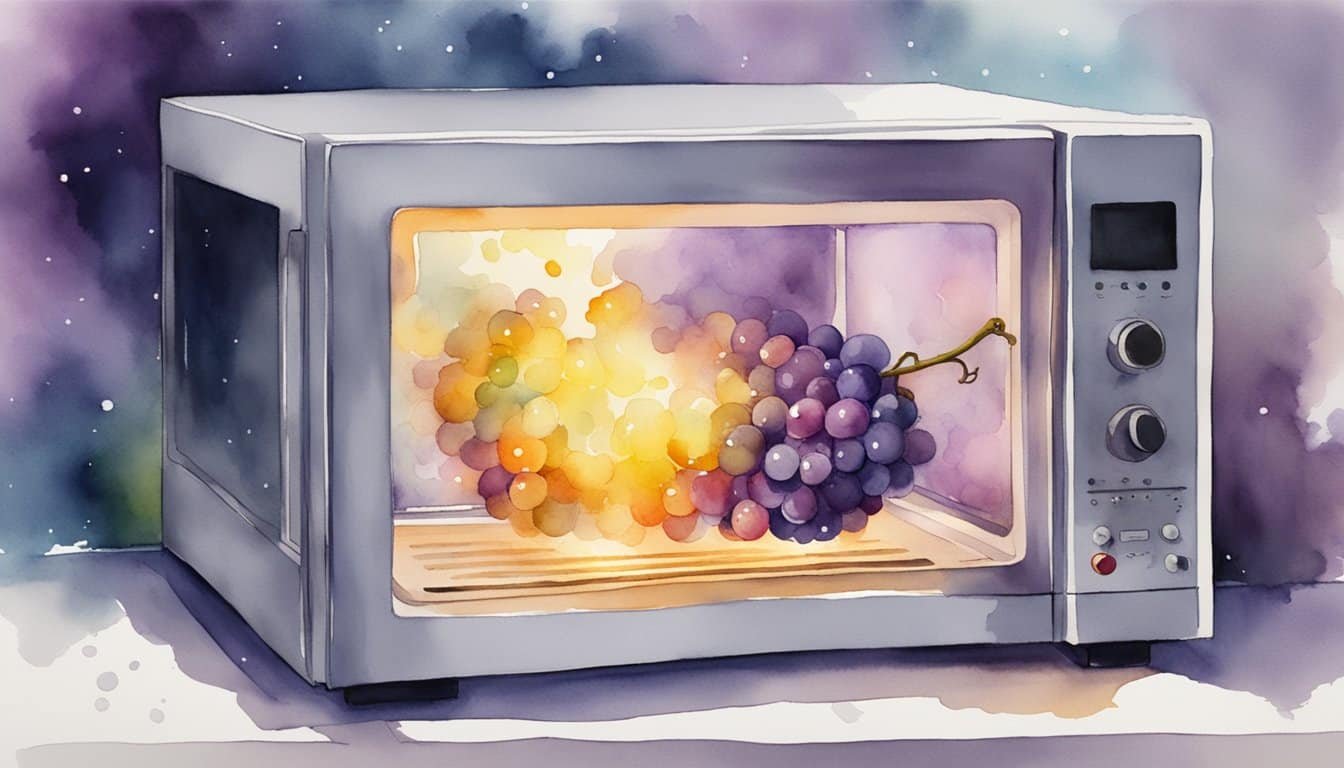Understanding Microwaves and Grapes
Microwaves are a form of electromagnetic radiation; they’re on the lower energy end of the electromagnetic spectrum, sandwiched between radio and infrared light. A microwave oven works by emitting this radiation to heat and cook food. When it comes to grapes, microwave ovens can trigger some pretty interesting reactions.
Typically, microwave radiation interacts with molecules in food, like water, fats, and sugars, causing them to vibrate and heat up quickly. However, grapes are small enough to fit within the microwaves’ electric field, which can set the stage for unusual scientific phenomena.
In a microwave, energy is transferred through the creation of an electromagnetic field. This field oscillates rapidly – billions of times per second – and it’s this rapid change that can cause localized heating effects. Due to the high water content in grapes, microwaves can generate a localized plasma, a state of matter created by free electrons and ions from the grape reacting to the electric field, leading to visible sparking.
The physics behind microwaving grapes is more complex than one might think. For instance, placing two grape halves close to each other in a microwave can enhance the electric field between them, resulting in a concentrated hotspot. It’s a fun demonstration of how energy and microwave radiation can create these exciting effects through the principles of science.
While this makes for a fascinating experiment, it’s crucial to remember that microwaves and grapes can be a messy combination if not handled properly. Microwaving them can result in damaged microwaves or even small fires, so safety should always come first in these deliciously scientific adventures!
The Phenomenon of Grape Plasma

When a grape is heated in the microwave, it can create a dazzling light show of plasma, a state of matter where electrons are freed from atoms to produce a glow. This spectacle isn’t just another kitchen trick, but a gateway to understanding complex scientific phenomena.
Mechanics of Plasma Formation
Plasma formation in a grape occurs when the fruit is microwaved, typically in halves. These grape hemispheres act as resonators for the microwave radiation. The microwave’s specific wavelength couples with the ionic content of the grape, generating localized hotspots that ultimately emit light and heat. This is akin to antennas transmitting radio waves, turning the grape into a source of intense energy.
Science Behind the Sparks
The sparks are the result of electrons being excited to a higher energy state and then releasing that energy as photons, or light particles, as they return to their lower energy state. Emitted at both visible and invisible wavelengths, these sparks are miniature versions of natural phenomena like lightning. Interestingly, a study published in the Proceedings of the National Academy of Sciences expands the understanding of this interaction by exploring the resonance phenomena within the grape’s aqueous environment.
Real-World Applications and Misconceptions
This microwave grape experiment has more than just shock value; it demonstrates principles that can be applied in various scientific fields, from photonics to energy harvesting. While some may falsely believe that any small fruit can produce the same effect, it’s important to note that the grape’s size and water content are crucial for the phenomenon to occur, debunking common misconceptions. It showcases the incredible potential of harnessing energy from everyday items under the right conditions.
Experimental Insights

Recent explorations into the interaction between grapes and microwaves have shed light on numerous fascinating phenomena. Researchers have embarked on innovative experiments, revealing more than just what happens when a grape encounters microwaves.
Studies and Discoveries by Researchers
Scientists have been captivated by the spectacle of plasma formation when grapes are heated in a microwave. A significant contributor to this field, Aaron Slepkov from Trent University, has illuminated the underlying mechanisms. It turns out that a skin bridge between two grape halves is critical to this process. When microwaves heat the grapes, the ions in the grapes’ juices turn into plasma.
Additionally, another set of experiments focused on drying of grapes under vacuum conditions with varying levels of microwave power. These studies offer insights into optimizing the drying process, contributing to more efficient ways to produce dried grapes with desired characteristics.
The Role of Simulations and Imaging
Simulations and thermal imaging techniques have become invaluable tools in dissecting the curious case of microwaving grapes. Computer simulations help to visualize and understand the electromagnetic field distribution and heat generation. Hamza Khattak, along with his team from Concordia University, has used advanced simulations to study the force between microwaved grapes. These computational insights complement the physical experiments, painting a more complete picture of this complex interaction.
Key Elements in Grape Microwaving

When it comes to microwaving grapes, several factors come into play that make it a unique process. Let’s take a closer look at what goes on with grapes in the world of microwaving!
Size and Skin Bridge: Grapes come in various sizes, but when microwaving, even the smallest spheres of fruity goodness can have big effects. If you place two grape halves in the microwave with a skin bridge connecting them, the intense electromagnetic field can turn them into plasma-beaming spheres!
Grape Skin: The skin of a grape holds the key to understanding its behavior under microwaves. Due to the surface conductivity of the skin, energy can build up, and with proper conditions, result in a light show worth posting on social media!
Simulation with Other Items: Now, if you’re out of grapes but curious about this phenomenon; no worries! Items like hydrogel beads, which are similar in size and water content to grapes, can yield similar effects. Same goes for a variety of kitchen items—think olives, blueberries, or even quail eggs—but remember, the results can vary greatly, so sticking to grapes might be your best bet for predictable excitement.
Comparing Halved to Whole Grapes: Are you considering microwaving whole grapes? Hold that thought! Without cutting them, they won’t create the same stunning plasma. It’s the halving and that crucial skin connection that makes all the difference.
Fun Fact: Who would’ve thought that your kitchen could transform into a mini science lab with just a grape and a microwave? These tiny fruit orbs aren’t just for snacking—they’re your ticket to a DIY science show! Remember to always be safe and supervise any of these fun experiments, especially around the curious eyes of young aspiring scientists.
Implications and Extended Research

Recent studies have sparked significant interest in the interaction between microwaves and grapes, propelling forward a range of scientific explorations. These investigations delve into resonant cavities and light scattering phenomena, becoming particularly pertinent in the fields of nanophotonics and nanoparticles.
Researchers discovered that grapes, when heated in a microwave, create plasma due to their shape acting as a resonant cavity. The study of this seemingly simple parlor trick, once thought to be a lucky coincidence, actually provides a window into fundamental principles of physics. This research can further aid the understanding of materials designed at a nanometer scale.
- Thermal-imaging techniques have proved instrumental in studying the thermal effects during microwave heating, offering insights into heat distribution and energy concentration.
In the realm of food science, microwaving grapes has highlighted the importance of salts—like potassium and sodium—which contribute to plasma formation. These essential ions impact the transfer of energy and are key in connecting various components at the molecular level.
Researchers are now considering the aqueous environment of hydrogel water beads as an analog to grape tissue, which helps in depicting the interface between grape’s skin and the microwave radiation. The mechanics of microwave interaction with different materials are ripe for research, potentially leading to the development of novel antenna designs.
As the inclination towards understanding climate change intensifies, the role of using microwaves in the preparation and preservation of food becomes even more profound. This could offer a method of enhancing food quality with less energy and has implications for respecting our planet.
In an era where undergraduate students often pioneer research, these nascent explorations offer more precise resolution and prediction models, leading to new understandings of the interaction between microwaves and organic materials.

